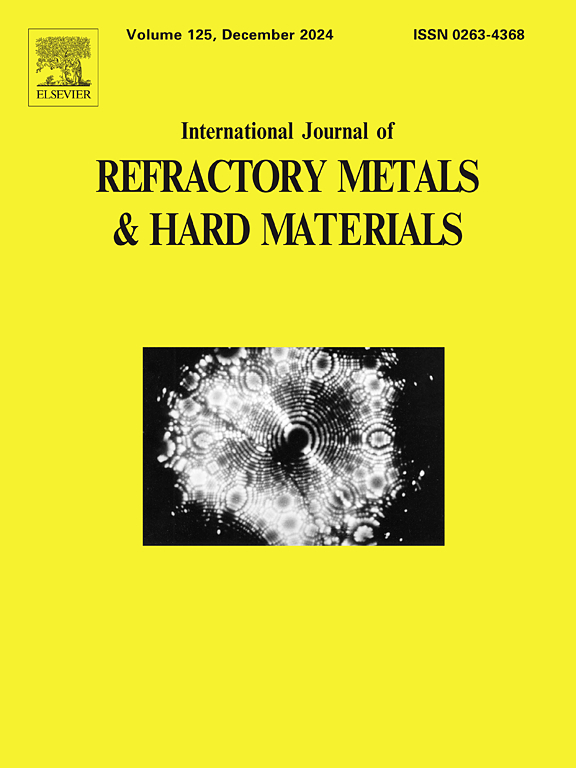Alloy design for powder bed fusion - laser beam: Grain boundary and segregation engineering in a novel molybdenum-boron-lanthanum alloy
IF 4.2
2区 材料科学
Q2 MATERIALS SCIENCE, MULTIDISCIPLINARY
International Journal of Refractory Metals & Hard Materials
Pub Date : 2025-03-17
DOI:10.1016/j.ijrmhm.2025.107156
引用次数: 0
Abstract
Molybdenum components manufactured using Powder Bed Fusion-Laser Beam (PBF-LB) currently cannot achieve the mechanical properties and quality of powder-metallurgically produced parts. This is a result of the process characteristics of steep thermal gradients and high solidification rates in PBF-LB, which promote the development of a coarse-grained, columnar microstructure. It has been observed that segregated oxygen impurities have a negative impact grain boundary cohesion, resulting in intergranular cracking and pore formation. This study aims to investigate the effect of a grain boundary and segregation engineering alloying approach for molybdenum using boron and lanthanum additions, and simultaneous adjustment of the PBF-LB process conditions.
Mo-B-La alloy specimens were manufactured from a Mo-1.5 wt% LaB6 powder blend by in-situ alloying in PBF-LB using varying substrate plate temperatures of 200 °C, 500 °C and 800 °C. The results show that all specimens exhibit a fine-grained microstructure. A grain size of between 15 and 21 μm was achieved owing to the solute rejection effect of B and La during solidification. The specimens exhibit a mixed cellular and columnar dendritic subgrain structure of α-Mo cells or dendrites surrounded by intercellular or interdendritic Mo2B filaments. La is found to support grain boundary purification from oxygen impurities owing to the formation of nanometer sized oxidic particles located at the interface between α-Mo and Mo2B. 60–80 % of the added La evaporates during the process, which leads to the formation of spherical gas pores with a size <Ø30 μm and limits the specimen's density to a maximum of 98.4 ± 0.4 %. The formation of cracks is significantly affected by the substrate plate temperature during the manufacturing process. Specimens manufactured at ≥500 °C are crack-free, while those produced at 200 °C exhibit cold cracks. Therefore, the bending strength of specimens manufactured at 200 °C is limited to 445 MPa, whereas those manufactured at 500 °C and 800 °C reach a bending strength of 1107 ± 117 MPa and 1210 ± 125 MPa, respectively, at room temperature. At elevated test temperatures, specimens demonstrate excellent properties, with bending strengths of 2151 ± 272 MPa and 1954 ± 510 MPa achieved at 400 °C and 600 °C, respectively.
The study concludes that the grain boundary and segregation engineering approach by alloying Mo with B and La, along with the simultaneous optimization of the process conditions by substrate plate heating, makes it possible to suppress the formation of the main quality inhibiting defects and to produce specimens with excellent mechanical properties in PBF-LB.

粉末床激光熔合合金设计:一种新型钼硼镧合金的晶界和偏析工程
目前使用粉末床熔合激光束(PBF-LB)制造的钼部件还不能达到粉末冶金生产部件的机械性能和质量。这是由于PBF-LB中陡峭的热梯度和高凝固速率的工艺特性,促进了粗晶柱状组织的发展。研究发现,分离的氧杂质会对晶界内聚力产生负面影响,导致晶间开裂和孔隙形成。本研究旨在探讨添加硼和镧的晶界和偏析工程合金化方法对钼的影响,并同时调整PBF-LB工艺条件。Mo-B-La合金试样由Mo-1.5 wt%的LaB6粉末混合物在PBF-LB中原位合金化,衬底温度分别为200℃、500℃和800℃。结果表明,所有试样的显微组织均呈细晶状。由于B和La在凝固过程中的溶质排斥作用,晶粒尺寸在15 ~ 21 μm之间。样品表现为α-Mo细胞或由细胞间或枝状间Mo2B细丝包围的混合细胞和柱状树突亚晶结构。La在α-Mo和Mo2B的界面处形成了纳米级的氧化颗粒,支持了氧杂质的晶界净化。60 ~ 80%的La在此过程中蒸发,形成尺寸为<;Ø30 μm的球形气孔,使试样的密度最大为98.4%±0.4%。在制造过程中,基材温度对裂纹的形成有显著影响。≥500°C的试样无裂纹,而200°C的试样出现冷裂纹。因此,在200℃下制作的试件的抗弯强度限制为445 MPa,而在500℃和800℃下制作的试件在室温下的抗弯强度分别为1107±117 MPa和1210±125 MPa。在较高的测试温度下,试样表现出优异的性能,在400°C和600°C下分别达到2151±272 MPa和1954±510 MPa的抗弯强度。研究结果表明,采用晶界和偏析工程方法将Mo与B、La合金化,同时通过基片加热优化工艺条件,可以抑制主要质量抑制缺陷的形成,并在PBF-LB中制备出具有优异力学性能的试样。
本文章由计算机程序翻译,如有差异,请以英文原文为准。
求助全文
约1分钟内获得全文
求助全文
来源期刊
CiteScore
7.00
自引率
13.90%
发文量
236
审稿时长
35 days
期刊介绍:
The International Journal of Refractory Metals and Hard Materials (IJRMHM) publishes original research articles concerned with all aspects of refractory metals and hard materials. Refractory metals are defined as metals with melting points higher than 1800 °C. These are tungsten, molybdenum, chromium, tantalum, niobium, hafnium, and rhenium, as well as many compounds and alloys based thereupon. Hard materials that are included in the scope of this journal are defined as materials with hardness values higher than 1000 kg/mm2, primarily intended for applications as manufacturing tools or wear resistant components in mechanical systems. Thus they encompass carbides, nitrides and borides of metals, and related compounds. A special focus of this journal is put on the family of hardmetals, which is also known as cemented tungsten carbide, and cermets which are based on titanium carbide and carbonitrides with or without a metal binder. Ceramics and superhard materials including diamond and cubic boron nitride may also be accepted provided the subject material is presented as hard materials as defined above.

 求助内容:
求助内容: 应助结果提醒方式:
应助结果提醒方式:


